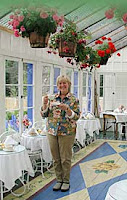(reposted and updated)
 |
| Sixth Avenue: Looking west from Broadway Today Hotel Mondomin sits kitty-corner, today's Eagles Bldg |
By 1910 the town’s once heady population of 10- to 20,000 (depending on who you listened to) had dribbled to 872. But if the Skagway Commercial Club is to be believed, she was coming into her own as a port of tourism, editorializing that she was “the natural headquarters for tourists and sightseers..., richer than the imagination can paint, greater in majesty and beauty than the far-famed Switzerland, and unsurpassed in loveliness of nature.” Nested between mountains at the mouth of a glacial river, approachable only by ship, and her only road out a narrow-gauge train track snaking up from the narrow valley floor to the fabled White Pass, she was a gem in the wilderness.
 |
| The Rapuzzi Family Outside Their Washington Grocery Store |
Yet there was still a cluttered and disorderly feel about town: mismatched boardwalks, too many seedy alleyways, empty lots vacated by yesterday’s hordes. In an online book published by the Parks Department, Robert Spude wrote that in order to walk down Broadway the pedestrian’s path would meander around the fruit crates at Rapuzzi’s store, by the sandwich sign at the Alaska Steamship Office, under the canvas awnings—some with signs on them—and through a host of space defined by the overflow and overhangs, openings and closing, of each narrow building.
Not the polished look a tourist-flirting Skagway was after.
She evened out her boardwalks, consolidated the red light district to just Paradise Alley between Sixth and Seventh Streets and closed the gap between the beach and Third Avenue by plucking two- and three-story buildings from other parts of town. When in 1914 the Red Onion Saloon and Brothel was hauled by a single horse from Sixth and State to its present location on the corner of Second and Broadway, Skagway found herself a mature, pretty little town with Victorian false storefronts corseted in tidy rank, flanking the railroad tracks and with the blush of youth and health in her face.
 |
| Broadway |
The wear of time began taking its toll, however; the sting of winter winds chafing her cheeks, peeling her paint, gravity sagging her storefronts and slanting her floors. The Depression years all but did her in and Skagway’s Chamber of Commerce began talking of a face lift. Not until June 1976, though, did a congressional bill establish the Klondike Gold Rush National Historical Park, a necessary first step if Skagway was to undergo not only a much needed face lift but reconstruction as well. A decade passed. Finally, when she was 86 years old (her downtown core absorbed by the park and well past her prime) she got the first of her reconstructive surgeries in a ongoing historic preservation project that makes today’s Skagway “one of the best preserved examples of the turn-of-the-last-century architecture.” This is the Skagway we see today.
Notice. No franchises. No golden arches, no Walmart, no Kentucky Fried. Not even a theater. Nothing to disrupt the illusion of yesteryear. Well, one disruption—Radio Shack down on Fourth, better known to the locals as the tanning salon, single booth in the back. Okay, one other disruption. But not in the historic district. The Harley Davidson shop up on 8th and Broadway falls into a block that simply has to “look” historical. Besides, it's not really a Harley Davison. It only sells T-shirts. And there is one other teensy-weensy exception. On the window right across the street from the old train depot you’ll see a Starbuck’s logo. Don’t let it fool you. This is just another place to shop where Mr. Star and Mr. Buck, I hear, are still selling their lattés and espresso. The rumor going around town is that when they landed in Skagway in 1897 they discovered their entire ton of goods to be nothing but 2,000 pounds of coffee. They’re still trying to get rid of them. But leave these three exceptions out of it—Radio Shack, Harley Davidson, and Starbucks—the rest of the town is authentic, which makes walking down Broadway and some of the city’s side streets a step back in time. You can tromp the wooden boardwalks and touch the walls of living history. What do they tell?
They tell a lot. Echoes beckon, linger, and whisper in every doorway, up the stairs, and all around.
They tell a lot. Echoes beckon, linger, and whisper in every doorway, up the stairs, and all around.
 |
| “a gem in the wilderness” |
______________________
If you're interested in more on Skagway, you can purchase my book Skagway: It's All About The Gold. Click on the cover image in the left sidebar.













